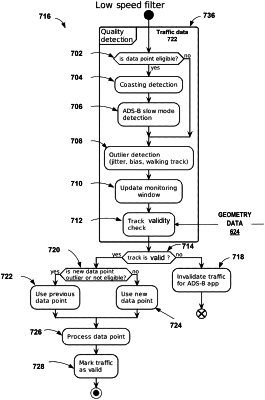| CPC G08G 5/0021 (2013.01) [G08G 5/0073 (2013.01); G08G 5/04 (2013.01)] | 17 Claims |

|
1. A system comprising:
a memory; and
processing circuitry operatively coupled to the memory, the processing circuitry configured to:
receive traffic data comprising target state information of a target derived from received Automatic Dependent Surveillance-Broadcast (ADS-B) messages, wherein the target state information comprises a target location, a target heading, and a target speed; and
filter the received traffic data to remove data points from the received traffic data, wherein to filter the received traffic data, the processing circuitry is further configured to:
receive a data point comprising the target state information;
perform a positional outlier check on the received data point, wherein to perform the positional outlier check, the processing circuitry is configured to check consistency of a respective location, respective heading, and respective speed information between successive data points;
perform a track validity check of a track of the target based on the received data point, wherein to perform the track validity check, the processing circuitry is configured to check the target location and heading against known geometry, wherein to check the target location and heading against known geometry comprises at least to compare the target location to a location and dimensions of terrain at a location in which horizontal accuracy is a factor;
in response to determining that the track of the target is invalid, remove the target from the received traffic data;
in response to determining that the track of the target is valid and in response to determining that the received data point is a positional outlier, delete the received data point and add a previous data point to the received traffic data stored at the memory and output an electronic signal comprising the received traffic data as filtered traffic data; and
determine whether an own-ship vehicle is in a high energy state or a low energy state;
in response to determining that the own-ship vehicle is in a low energy state, apply a low-speed filter to the received data point, wherein to apply the low-speed filter the processing circuitry is configured to:
detect an ADS-B slow mode from the target, wherein to detect the ADS-B slow mode from the target is based on determining timing of receiving the data point from the target;
detect a walking track error, wherein to detect the walking track error, the processing circuitry is configured to determine that the target is slowly deviating from the actual stationary, or low speed, position; and
determine whether the received data point is generated by a coasting function, wherein the coasting function is configured to assume that the target is moving at the last known heading and speed in response to not receiving an expected data point and then predict and generate an internal data point for the target.
|